It looks like you're using an Ad Blocker.
Please white-list or disable AboveTopSecret.com in your ad-blocking tool.
Thank you.
Some features of ATS will be disabled while you continue to use an ad-blocker.
share:
originally posted by: swanne
originally posted by: [post=19112784]Soylent Green Is but if it is self-illuminating, then I assure you that would be jaw-dropping information.
And even if it is self-illuminating (which I very much doubt), it doesn't necessarily imply that it would be artificial in nature - a simple phosphorescent substance could be the candidate.
I agree, but considering we don't have the data to definitively say what it is yet, or what it isn't, I suppose we need to keep "self-illuminating" on the table.
If I were to hazard a guess, I'd say it's reflective material, such as ice or some sort of mineral salts. However, we'll have to wait and see before we can do anything but guess.
edit on 3/13/2015 by Soylent Green Is People because: (no reason given)
a reply to: JadeStar
Through the years it has been my extreme pleasure to work with some of the most mature and caring people on this earth, and maybe from even further. I have been taught far more about myself that I ever would have imagined possible. And they have taught me many things about being mature, and acting like an adult.
I wish you luck.
I have already addressed the object in question in the above post.
Your "theories" are wacked out and have no scientific basis. It's a UV image of IO not some planet core.
Through the years it has been my extreme pleasure to work with some of the most mature and caring people on this earth, and maybe from even further. I have been taught far more about myself that I ever would have imagined possible. And they have taught me many things about being mature, and acting like an adult.
I wish you luck.
I suppose we need to keep "self-illuminating" on the table.
Thank you kindly, its the honest thing to do
edit on 13-3-2015 by All Seeing Eye because: (no reason given)
originally posted by: intergalactic fire
a reply to: All Seeing Eye
Don't know if you ever heard of this alternative theory of planet formation.
I thought maybe you might find this interesting.
Thank you for the link. And no, never heard of it before.
His theory rely s on a central core of iron. I disagree with this. What is at the core of any planet has never been proven beyond a reasonable doubt, to me. Until we send a crew down to the core, it will only be a theory. Unless, we happen to find a core floating about in space. Which might happen fairly soon. Fingers crossed.
I do agree with the speakers opinion on the current condition of the "Religion of mathematical physics". It is illogical for mature adults to become Emotional children when faced with new ideas, concepts, to old questions. Unless that is, they have a hidden agenda.
The concept of planets being extinguished suns is very interesting, but is that what we see? I would imagine there would be far less diversity of materials after it is burnt out, if, its on fire in the first place. I'm not quite convinced its a Nuclear reaction as we think we know. It is obvious it is a chain reaction of some type.
There is little doubt in my mind that reused materials do end up all over creation, you can see that in the Hubble photos. So yes, old planet stuff, old Sun stuff, can be found, everywhere. 2, 3, 4, 5 times through the mill is very possible. But for materials to just hap haphazardly come together in one spot over another? The Hubble photos actually do show a type of spacing, and symmetry between galaxies, and obviously where they collide. But the symmetry is in the unique angles from one another. Their unique spirals make them unique "Individuals" to themselves. This, is, what we see. And it is not out of the realm of possibilities, that each Galaxy have its own set of "Physics Laws", so what applies in one may not entirely apply in another.
No matter how hard mankind tried to make Nature fit its "Created Rules", Nature will throw you another curve ball. That's just the way it is. We can theorize, we can dream, we can trick people into believing the world is flat, but when it comes to Nature, it writes the rules, we, can only observe them.
originally posted by: Soylent Green Is People
originally posted by: All Seeing Eye
Now, we are collectively looking at a relic of creation. But what is it we are actually looking at??? An asteroid, a dwarf planet, or might it be, something entirely different. We see a light!
Well, we see a bright patch, not necessarily a light. We don't "know" if it is reflective or self-illuminating -- but if it is self-illuminating, then I assure you that would be jaw-dropping information. However, there is no reason to believe it is NOT just something that is relatively highly reflective.
As for the term "dwarf planet" or "asteroid", they are just different words for the general "lumps of stuff floating around in the solar system". Don't get too caught up in words.
I respectfully disagree with the assertion that there is no reason to believe it (the bright spot on Ceres) is not just something that is relatively highly reflective. Some of the latest images of Ceres show the bright spot on the floor of the crater, surrounded in darkness. That location has already crossed over the terminator between day and night.
How can a merely reflective object reflect light when there is none? The explanation that the bright spot is on elevated terrain, and so, is catching the last rays of the Sun, even though the crater floor is dark appears to be invalid.
NASA looked carefully for elevated terrain at the site of the bright spot, because they were searching for evidence of an icy volcano. They found no such elevated terrain. Their finding seemed solid enough to them that they virtually ruled out the possibility of an icy volcano.
edit on
14-3-2015 by Ross 54 because: improved paragraph structure
originally posted by: Ross 54
originally posted by: Soylent Green Is People
originally posted by: All Seeing Eye
Now, we are collectively looking at a relic of creation. But what is it we are actually looking at??? An asteroid, a dwarf planet, or might it be, something entirely different. We see a light!
Well, we see a bright patch, not necessarily a light. We don't "know" if it is reflective or self-illuminating -- but if it is self-illuminating, then I assure you that would be jaw-dropping information. However, there is no reason to believe it is NOT just something that is relatively highly reflective.
As for the term "dwarf planet" or "asteroid", they are just different words for the general "lumps of stuff floating around in the solar system". Don't get too caught up in words.
I respectfully disagree with the assertion that there is no reason to believe it (the bright spot on Ceres) is not just something that is relatively highly reflective. Some of the latest images of Ceres show the bright spot on the floor of the crater, surrounded in darkness. That location has already crossed over the terminator between day and night.
How can a merely reflective object reflect light when there is none? The explanation that the bright spot is on elevated terrain, and so, is catching the last rays of the Sun, even though the crater floor is dark appears to be invalid.
NASA looked carefully for elevated terrain at the site of the bright spot, because they were searching for evidence of an icy volcano. They found no such elevated terrain. Their finding seemed solid enough to them that they virtually ruled out the possibility of an icy volcano.
Just to make sure, this is the photo you are referring to, correct?

My only question is, when Dawn gets to the dark side, will they make the photos public?? Because if that light is still present, someone will have a lot of explaining to do. Of course they can always say its bio-luminescence, and they have discovered a new life form.
a reply to: All Seeing Eye
In all scientific fairness, and just by going upon what we see here, it appears that these spots are indeed reflective in nature. When we see these 2 spots directly, they are both very bright, but the one on the left is brighter than the other. Now, that they are shown on the termination point of sunlight hitting Ceres, the spot on the right is still noticeable, however has dimmed almost to invisibility. That suggests that it is a reflecting source, just as the bright one to the left. The reason is perhaps an out-gassing effect, where the spot on the left is spewing gas at a higher elevation, thus still maintaining visibility longer, as the area rotates into the complete darkness.
Again, solely based upon what we see.
In all scientific fairness, and just by going upon what we see here, it appears that these spots are indeed reflective in nature. When we see these 2 spots directly, they are both very bright, but the one on the left is brighter than the other. Now, that they are shown on the termination point of sunlight hitting Ceres, the spot on the right is still noticeable, however has dimmed almost to invisibility. That suggests that it is a reflecting source, just as the bright one to the left. The reason is perhaps an out-gassing effect, where the spot on the left is spewing gas at a higher elevation, thus still maintaining visibility longer, as the area rotates into the complete darkness.
Again, solely based upon what we see.
a reply to: charlyv
In all scientific fairness, we need to look straight down, on the dark side. The effect your espousing could also be caused by the depth of the light/reflection. If the source of the light/reflection is deeper than the surface, lets say 600 feet, it would not be seen in a shallow angle shot. The walls of the opening could shield the light going in, or coming out.
This light may not be 2D, but 3D.
In all scientific fairness, we need to look straight down, on the dark side. The effect your espousing could also be caused by the depth of the light/reflection. If the source of the light/reflection is deeper than the surface, lets say 600 feet, it would not be seen in a shallow angle shot. The walls of the opening could shield the light going in, or coming out.
This light may not be 2D, but 3D.
edit on 14-3-2015 by All Seeing Eye because: (no reason given)
Supposing that they attempt to photograph the unlit side of Ceres at some point, and that the bright spot is still apparent: Will we be allowed to see
the images? I'm inclined to think so.
They're already let us see an image with the bright spot surrounded by darkness, and dismissed the only likely routine explanation, a mound or peak, as part of their own analysis.
As for the way the bright spots fade out, somewhat after the crater floor falls dark for the night: It appears to me that the bright spots, particularly the brighter one, gets flatter and flatter in appearance.
I believe that they experience geometric foreshortening. As Ceres rotates, they are seen at a greater and greater angle. Eventually they are presented edge-on, and having little or no height, they disappear from view.
They're already let us see an image with the bright spot surrounded by darkness, and dismissed the only likely routine explanation, a mound or peak, as part of their own analysis.
As for the way the bright spots fade out, somewhat after the crater floor falls dark for the night: It appears to me that the bright spots, particularly the brighter one, gets flatter and flatter in appearance.
I believe that they experience geometric foreshortening. As Ceres rotates, they are seen at a greater and greater angle. Eventually they are presented edge-on, and having little or no height, they disappear from view.
edit on 14-3-2015 by Ross 54 because: improved paragraph
structure
edit on 14-3-2015 by Ross 54 because: improved paragraph structure
a reply to: Ross 54
If it turns out to be a basin of silver or gold they will never tell us. Theres gold in them hills how many private companies in space technology would suddenly spring up.
They're already let us see an image with the bright spot surrounded by darkness, and dismissed the only likely routine explanation, a mound or peak, as part of their own analysis.
If it turns out to be a basin of silver or gold they will never tell us. Theres gold in them hills how many private companies in space technology would suddenly spring up.
It's just possible they'll find the bright spot is something a great deal more valuable than gold, scientifically speaking.
a reply to: AthlonSavage
And the per ounce price of retrieving any of it would be?
But that would be a bad thing?
If it turns out to be a basin of silver or gold they will never tell us. Theres gold in them hills how many private companies in space technology would suddenly spring up.
And the per ounce price of retrieving any of it would be?
But that would be a bad thing?
edit on 3/14/2015 by Phage because: (no reason given)
This talk about "allowing" or "not allowing" is very funny. The images will be held for study by the scientists and the Dawn team, but after a certain
period they will be released in the public PDS archive, like all other spacecraft images are. pds.nasa.gov...
For example, here are a couple of images of Vesta I pulled from sbn.psi.edu...
(right-click on the images and select "View Image" to see them full-size)


For example, here are a couple of images of Vesta I pulled from sbn.psi.edu...
(right-click on the images and select "View Image" to see them full-size)


edit on 15-3-2015 by wildespace because: (no reason given)
Here's a cool animation showing how (and when) Dawn goes into an orbit around Ceres: www.youtube.com...
As you can see, today and for the rest of March, Dawn is on the dark side of Ceres, and will move into a closer orbit very gradually. From around mid-April, it will start going over the sunlit side, and I think that's when we'll see first close-up pictures.
As you can see, today and for the rest of March, Dawn is on the dark side of Ceres, and will move into a closer orbit very gradually. From around mid-April, it will start going over the sunlit side, and I think that's when we'll see first close-up pictures.
originally posted by: Ross 54
I respectfully disagree with the assertion that there is no reason to believe it (the bright spot on Ceres) is not just something that is relatively highly reflective. Some of the latest images of Ceres show the bright spot on the floor of the crater, surrounded in darkness. That location has already crossed over the terminator between day and night.
But that image in question did not show the bright spot on the floor of the crater, surrounded in darkness; it did not show that location has already crossed over the terminator between day and night -- not completely.
Here are a series of 27 images that show Ceres spinning on its axis. The top row shows the bight spot spinning toward the dark side:
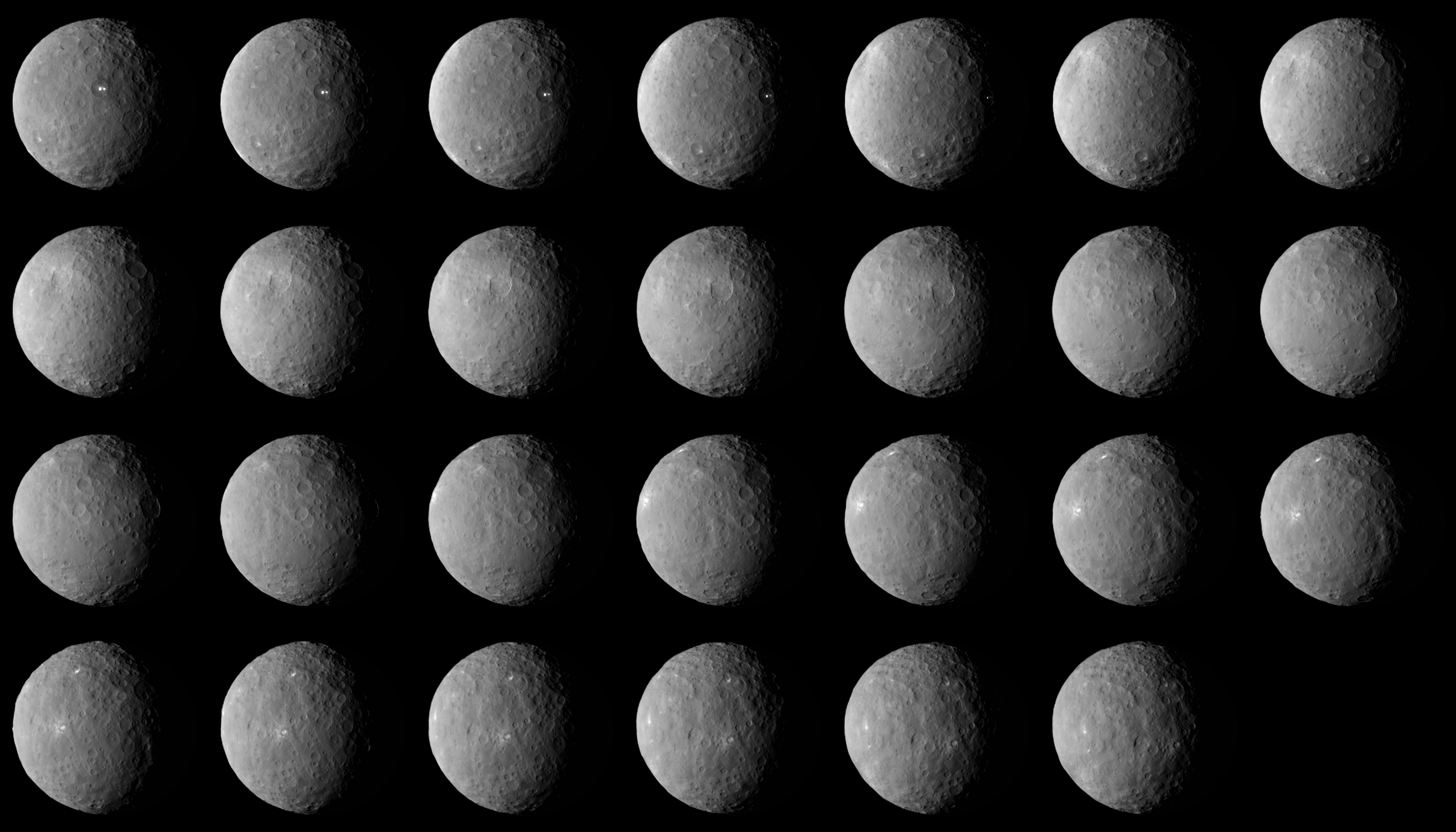
This is the final image in that series in which the bright spot can be seen, and this is the image you mentioned that "shows the bright spot on the floor of the crater, surrounded in darkness.":
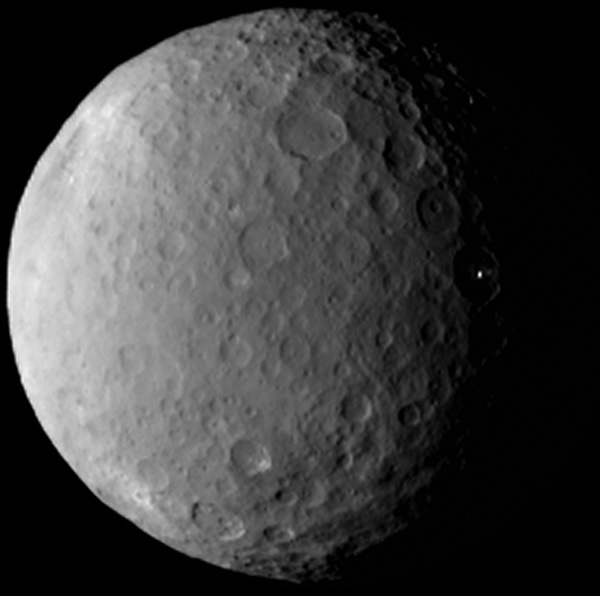
However, if you look closely, you can see that the spot is not surround by darkness. Fist off, the rim of the crater is still visible on the right; that rim is still in sunlight because it is higher than the surrounding areas in darkness. In addition, you can see (in the image below) that there are other parts of the floor of the crater near the bright spot that are visible, perhaps because they are raised up a little higher than the dark areas of that same crater floor:
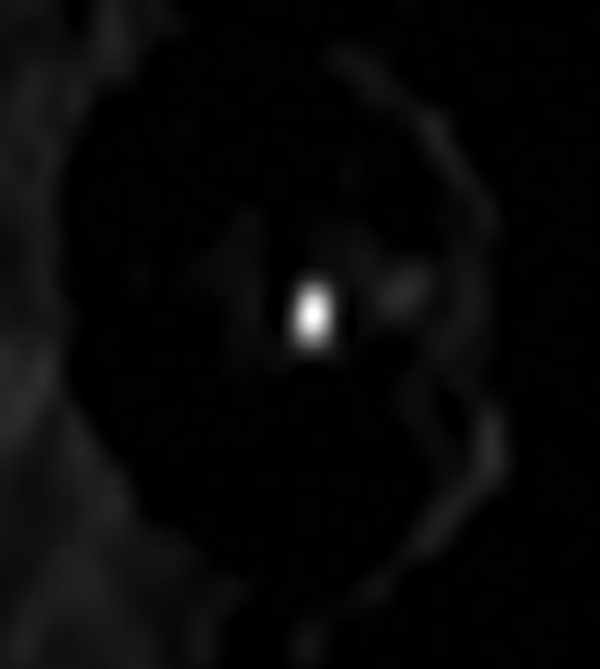
In this next image, I turned up the brightness level to see it even better:
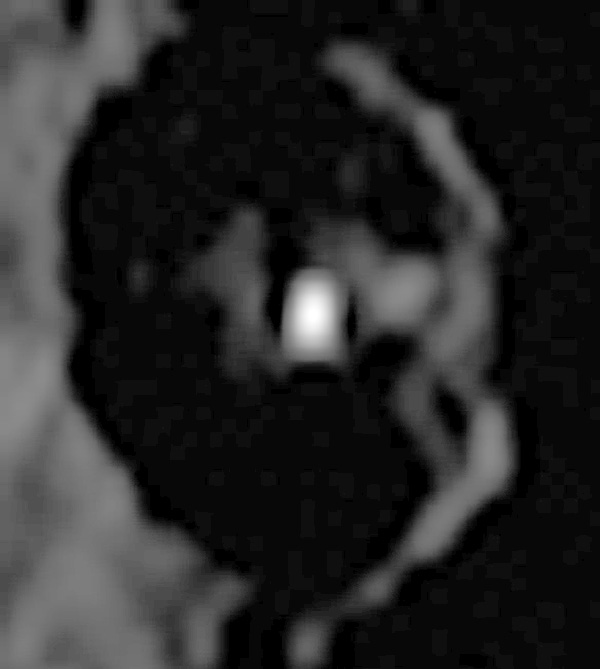
This next imageis the fist in that series in which the bright spot cannot be seen. However, the crater it is in should still be visible, but just completely across the terminator:
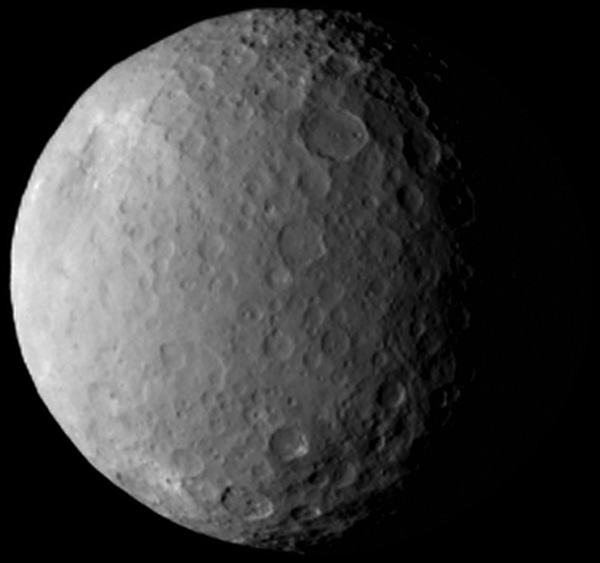
Here is that same image, but with the approximate location of the crater shown by a circle (you can actually still see a very small piece of the right rim that is still just a little bit in sunlight):
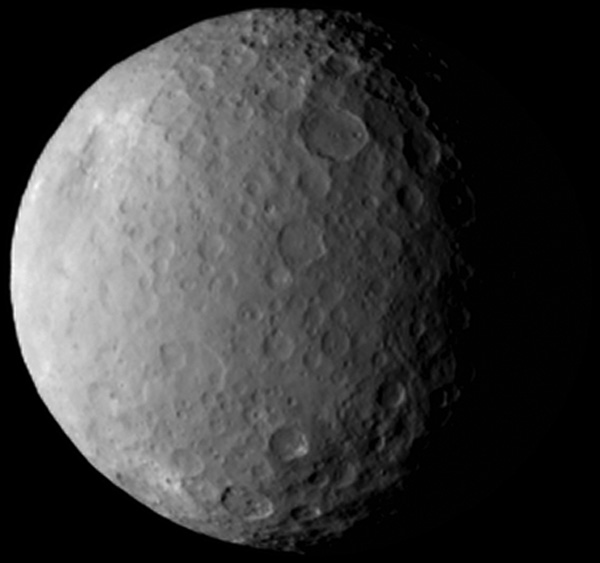
This above image shows when the crater is truly completely on the dark side of the terminator, and the bright spot is not visible.
We don't yet know the topography of Ceres and the floor of that crater in which the bright spot resides. Dawn has not yet got close enough to do a detailed radar mapping of the topography, so I cannot say for sure whether or not the bright spot in the image you mentioned...
...However, we also can't say for sure that it cannot have been high enough to be able to reflect light. By that enlarged image I showed, it looks as if there were other parts of the floor of that very dark crater that were receiving some sunlight.
Like I said, I can't say for sure whether or not this is definitely a reflected surface of some sort, but even after these above images came out, mission scientist still thought that one explanation was that it was some sort of highly reflective material. Here is an article from just 5 days ago (March 10) in which one of the mission scientists talks about the possible materials that could cause such a reflection:
In this case, the feature is very reflective. There isn't something there signaling us actively. It's signaling us passively; it's reflecting the sunlight. It's consistent with reflecting all of the light if the spot is small enough. Now, we don't know what size it is, so we can't tell if the albedo is 40 percent, 60 percent, 80 percent or 100 percent, but it's probably in that range someplace. One thing that's very good in the solar system at reflecting sunlight is ice. For example, [Saturn's moon] Enceladus has an albedo of about 100 percent.
But there are people who are holding out for salt — not necessarily table salt, but salts of various minerals that may be white in appearance. So we have sort of a dichotomy of opinion in the team as to whether this has a dry or wet explanation. But we'll get to the bottom of this when we can resolve the bottom of the feature.
Source:
Studying Dwarf Planet Ceres: Q&A with Dawn Scientist Chris Russell
An elevation in the terrain at the location of the bright spot was looked for, but was not found . NASA was satisfied with their ability to make this
determination, to the extent that it caused them to essentially eliminate the possibility of a mound- creating cryovolcano as an explanation for
the bright spot.
Even with the light levels in the crater artificially enhanced to a large degree, it appears that the bright spot still has darkness touching it at nearly all points of its perimeter.
I have a couple of other serious misgivings about the images you produced.
First, I'm told that pushing the light levels up to an extreme like this can create illusory lighted shapes that are not actually present. Digital image artifacts can apparently be emphasized, to the point that they appear real.
Second, even if the very dimly lighted areas in the crater you point to are real, and not spurious, they could be light spilling from the bright spot, onto the crater floor.
The fact that certain points of high relief are still illuminated, that lie to the bright spot's right does not establish that the terminator between day and night has not been crossed, as far as lower elevation areas, like the floor of the crater, are concerned. The terminator on a cratered world, like Ceres, is far from being a smooth, or even continuous line.
In watching the series of images of Ceres' rotation, it appeared to me that the bright spot gradually flattened out. This looks to be to be a case of geometrical foreshortening. The bright spot appears to have finally faded out when it was presented to us edge-on. If it has no vertical component, this is just what we should expect to see.
Even with the light levels in the crater artificially enhanced to a large degree, it appears that the bright spot still has darkness touching it at nearly all points of its perimeter.
I have a couple of other serious misgivings about the images you produced.
First, I'm told that pushing the light levels up to an extreme like this can create illusory lighted shapes that are not actually present. Digital image artifacts can apparently be emphasized, to the point that they appear real.
Second, even if the very dimly lighted areas in the crater you point to are real, and not spurious, they could be light spilling from the bright spot, onto the crater floor.
The fact that certain points of high relief are still illuminated, that lie to the bright spot's right does not establish that the terminator between day and night has not been crossed, as far as lower elevation areas, like the floor of the crater, are concerned. The terminator on a cratered world, like Ceres, is far from being a smooth, or even continuous line.
In watching the series of images of Ceres' rotation, it appeared to me that the bright spot gradually flattened out. This looks to be to be a case of geometrical foreshortening. The bright spot appears to have finally faded out when it was presented to us edge-on. If it has no vertical component, this is just what we should expect to see.
edit on 15-3-2015 by Ross 54 because: added apostrophe, improved word use
a reply to: Soylent Green Is People
This by far is the most revealing image to date. Thank you for posting.

It now appears that the second "Light" is not a light, but a reflection off of the inner crater wall, right side.
The photo appears to be taken from roughly a 50 Deg angle, so we are not looking exactly straight down, at a 90 Deg angle.
Sunlight is shining on the left outer and left inner wall, and the inside of the right outer wall, and inside of the right inner wall. And from your enhance photo it is obvious the second bright area, is a reflection. There can be little doubt about it now.
There is little doubt at all that the bright area in the center of the crater, is in the center, which I think significant. The reflected light on the right may actually be the meteor which caused the crater in the first place. And for what ever reason, bounced back out and landed to the right of center. There are a few craters on Mars that have rebound rings around them, so bouncing Meteors could be a possibility.
The Inner left wall is throwing shadow to the middle of the inner floor, but the light is unaffected by this. If the meteor hit a highly reflective deposit, the meteor may have some of that deposit on the impact side. So if that, the second reflection, the impact meteor, shows no reflection of the same intensity as the center light, then it did not hit a reflective deposit. Again that is, if the structure to the right is in fact the impact meteor. Which to me, looks like it could be.
If the light is a result of out gassing of any sort, then the plum should be very visible anywhere up to 90 Deg of the camera.
I'm afraid at this point, options to the genesis of this "light" are few and far between. And by looking at your enhanced photo, and considering the angle the photo was taken, I am left with the feeling that I am looking down a hole. I'm sorry, but that is the impression. Besides, the very nature of meteors is that, they dig holes
Besides that, the floor of the center to the right of the light, is also in the dark. And if this is a sort of volcano, well, I can see no shadow thrown to the right of a tall structure or deposit.
So, if the light is actually a hole projecting light from within, no light would be seen at a 50 Deg angle as it turns into the dark side. To decide one way or another, we need a photo from the dark side straight up from the light, looking down.
Great photo, again, thank you.
This by far is the most revealing image to date. Thank you for posting.

It now appears that the second "Light" is not a light, but a reflection off of the inner crater wall, right side.
The photo appears to be taken from roughly a 50 Deg angle, so we are not looking exactly straight down, at a 90 Deg angle.
Sunlight is shining on the left outer and left inner wall, and the inside of the right outer wall, and inside of the right inner wall. And from your enhance photo it is obvious the second bright area, is a reflection. There can be little doubt about it now.
There is little doubt at all that the bright area in the center of the crater, is in the center, which I think significant. The reflected light on the right may actually be the meteor which caused the crater in the first place. And for what ever reason, bounced back out and landed to the right of center. There are a few craters on Mars that have rebound rings around them, so bouncing Meteors could be a possibility.
The Inner left wall is throwing shadow to the middle of the inner floor, but the light is unaffected by this. If the meteor hit a highly reflective deposit, the meteor may have some of that deposit on the impact side. So if that, the second reflection, the impact meteor, shows no reflection of the same intensity as the center light, then it did not hit a reflective deposit. Again that is, if the structure to the right is in fact the impact meteor. Which to me, looks like it could be.
If the light is a result of out gassing of any sort, then the plum should be very visible anywhere up to 90 Deg of the camera.
I'm afraid at this point, options to the genesis of this "light" are few and far between. And by looking at your enhanced photo, and considering the angle the photo was taken, I am left with the feeling that I am looking down a hole. I'm sorry, but that is the impression. Besides, the very nature of meteors is that, they dig holes
Besides that, the floor of the center to the right of the light, is also in the dark. And if this is a sort of volcano, well, I can see no shadow thrown to the right of a tall structure or deposit.
So, if the light is actually a hole projecting light from within, no light would be seen at a 50 Deg angle as it turns into the dark side. To decide one way or another, we need a photo from the dark side straight up from the light, looking down.
Great photo, again, thank you.
*double post. See posts below.
edit on 3/17/2015 by Soylent Green Is People because: (no reason given)
new topics
-
BIDEN Admin Begins Planning For January 2025 Transition to a New President - Today is 4.26.2024.
2024 Elections: 4 hours ago -
Big Storms
Fragile Earth: 5 hours ago -
Where should Trump hold his next rally
2024 Elections: 8 hours ago -
Shocking Number of Voters are Open to Committing Election Fraud
US Political Madness: 9 hours ago -
Gov Kristi Noem Shot and Killed "Less Than Worthless Dog" and a 'Smelly Goat
2024 Elections: 9 hours ago -
Falkville Robot-Man
Aliens and UFOs: 10 hours ago -
James O’Keefe: I have evidence that exposes the CIA, and it’s on camera.
Whistle Blowers and Leaked Documents: 10 hours ago -
Australian PM says the quiet part out loud - "free speech is a threat to democratic dicourse"...?!
New World Order: 11 hours ago
top topics
-
James O’Keefe: I have evidence that exposes the CIA, and it’s on camera.
Whistle Blowers and Leaked Documents: 10 hours ago, 17 flags -
Australian PM says the quiet part out loud - "free speech is a threat to democratic dicourse"...?!
New World Order: 11 hours ago, 15 flags -
Blast from the past: ATS Review Podcast, 2006: With All Three Amigos
Member PODcasts: 14 hours ago, 14 flags -
Biden "Happy To Debate Trump"
2024 Elections: 12 hours ago, 13 flags -
Ireland VS Globalists
Social Issues and Civil Unrest: 12 hours ago, 10 flags -
Mike Pinder The Moody Blues R.I.P.
Music: 15 hours ago, 9 flags -
BIDEN Admin Begins Planning For January 2025 Transition to a New President - Today is 4.26.2024.
2024 Elections: 4 hours ago, 8 flags -
What is the white pill?
Philosophy and Metaphysics: 14 hours ago, 6 flags -
Shocking Number of Voters are Open to Committing Election Fraud
US Political Madness: 9 hours ago, 6 flags -
Big Storms
Fragile Earth: 5 hours ago, 6 flags
active topics
-
Gov Kristi Noem Shot and Killed "Less Than Worthless Dog" and a 'Smelly Goat
2024 Elections • 64 • : cherokeetroy -
What is the white pill?
Philosophy and Metaphysics • 23 • : TheDiscoKing -
BIDEN Admin Begins Planning For January 2025 Transition to a New President - Today is 4.26.2024.
2024 Elections • 21 • : worldstarcountry -
University of Texas Instantly Shuts Down Anti Israel Protests
Education and Media • 317 • : CriticalStinker -
Ditching physical money
History • 23 • : worldstarcountry -
Australian PM says the quiet part out loud - "free speech is a threat to democratic dicourse"...?!
New World Order • 9 • : ScarletDarkness -
-@TH3WH17ERABB17- -Q- ---TIME TO SHOW THE WORLD--- -Part- --44--
Dissecting Disinformation • 704 • : 777Vader -
Mood Music Part VI
Music • 3113 • : MRTrismegistus -
One Flame Throwing Robot Dog for Christmas Please!
Weaponry • 12 • : worldstarcountry -
RAAF airbase in Roswell, New Mexico is on fire
Aliens and UFOs • 13 • : Ophiuchus1
